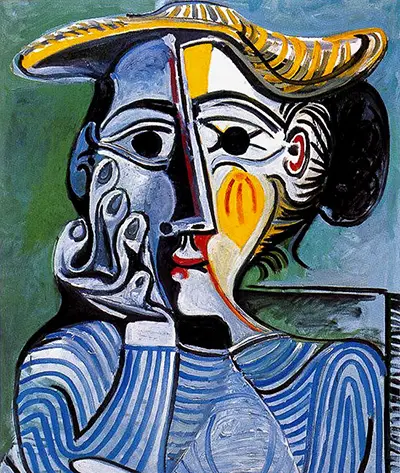The portrait shown on this page was titled Femme au Chapeau Jaune, or Woman with Yellow Hat.
There is believed to be a total of around 400 portraits of Jacqueline Roque from Picasso's career - as an elderly Pablo showed no sign of slowing down in his later years.
The highlights from this extensive collection of work included the likes of Jacqueline with Flowers, Jacqueline a Mantille Sur Fond Rouge and Jacqueline au Chevalet.
Pablo moved in with Jacqueline, his final model, in 1954.
They would eventually marry in 1961, by which time Jacqueline had appeared in countless portraits and ceramics, in a wide range of poses and styles.
The massive age gap would deter Jacqueline from accepting Pablo's advances for quite a long time. Finally, she was wooed by some artistic work that he gifted her.
Picasso continuously chased the younger woman throughout his life, even into his seventies. He was not someone who felt or feared becoming old, essentially behaving much the same way throughout his lengthy career.
Whilst most liasons with a 45-year age gap would be doomed to eventual failure, it was only Picasso's death at 91 that would finally pull these two apart.
The artist's previous relationships with the likes of Fernande Olivier, Dora Maar and Marie-Thérèse Walter have always drawn more interest from academics.
Only recently have there been exhibitions entirely devoted to Roque's portraits, such as in 2006 at the Kunst Museum in Münster, Germany.
There had been relatively little focus on the later stages of Picasso's career until quite recently. Regarding this period, art author Richardson called it Picasso's "L'Époque Jacqueline."
Many have commented that Jacqueline brought the artist a comforting peace which would show in his work at this time. Their love brought a tranquility rarely seen before across Pablo's life.
There has also been much negativity surrounding Jacqueline from those who studied this period in his life. Whilst creating tranquility on the one hand, it may have been achieved by disconnecting Pablo from his family.
She never really linked up with others in his life, and this carried on after his death. It is fair to say that her influence was both positive and negative, but always significant.
History can often be unfair or inaccurate in how it judges those from the past. Jacqueline's poor relationship with others in his social group may have played a role in this negative coverage of her relationship with Picasso.
Tragedy was a strong theme in Picasso's life and even after he had passed away, it continued. Jacqueline would take her own life after never really recovering from the death of her husband.
Several others lovers, plus also Picasso's son, would pass away under odd or unfortunate circumstances.
Speaking about a rare exhibition aimed at this specific romance, "There are more portraits of Jacqueline than any other woman in Picasso's life," says Arne Glimcher, Pace's founder. "The range of interpretation of her image is quite extraordinary. We've selected works representing all of these moments, from the time he meets her and draws her like Ingres, till the end of his life, when his work was marked by wild expressionism. So you see the transformation of his late style only through these portraits of Jacqueline."

